Abstract
Electrically-assisted cycling can make a major contribution to sustainable mobility. For some people, hills are a barrier for cycling. This paper focuses on how and why electrically-assisted bikes make a difference to cycling in hilly contexts, and can thus be an important element of sustainable mobility in hilly geographies. It makes a novel contribution in being able to draw on recorded sensor data of the actual use of assistance in relation to the specific geography of the route cycled (GPS data), and interview/survey material. It shows that e-bikes extend the range, nature and scope of journeys manageable by bike, and therefore the general viability of e-bikes as alternative to other modes. It highlights that the benefits of using e-bikes are often also psychological, since they can change the overall enjoyability of the cycling experience in hilly areas. Resulting policy recommendations, that could lead to significant CO2 savings through the uptake of e-cycling in hilly contexts, include ‘try before you buy’ schemes, training for e-bike users and investing in relevant cycling infrastructure.
1. Introduction
Transport is one of the major global contributors to climate change, “responsible for approximately 23% of total energy-related CO2 emissions”, as the IPPC 2014 concludes [1]. Recent responses to this issue include the European Commission’s aim that “greenhouse gas emissions from transport will need to be at least 60% lower than in 1990 and be firmly on the path towards zero” [2]. For individual ground transportation, these efforts to reduce transport-related carbon emissions will have to include a variety of sustainable modes of transport. Light and active modes of mobility will need to play a key role, as acknowledged by the European Commission [2]. Bicycles are a relatively sustainable mode of transport and an increase in cycling rates can make a major contribution to reducing transport-related carbon emissions. The growing popularity of electrically-assisted bicycles does and can play a key role in the shift towards higher cycling rates and a transition towards more sustainable transport [3], including modal shift away from car driving [4]. Barriers to (e-)cycling are discussed widely in the academic and policy literature. Whilst many of these mention hilliness as a general issue (as discussed below), there are no publications specifically dedicated to this topic. This paper fills this gap by focusing on how electrically-assisted bikes can help encourage cycling in hilly geographies, and what the implications are for future sustainable mobility.
The paper draws on qualitative and quantitative research material from an intervention in Brighton, UK, including GPS data, sensor data about the use of assistance, and qualitative interviews. It focuses on everyday utility cycling, e.g., for commuting (not racing or touring). It extends the existing literature by making hilliness the central research focus, and by using detailed empirical data to investigate the topic.
In doing so, it highlights a range of important findings. As well as endorsing the generally-accepted truth that e-bikes provide a practical solution to overcome hilliness on particular journeys, it also shows that e-bikes extend the range, nature and scope of journeys that are manageable by bike, and therefore the more general viability of e-bikes as an alternative to other forms of transport. It highlights that the benefits of using e-bikes are often also psychological, since they can change the overall enjoyability of the cycling experience in hilly areas, for example, by providing a relatively attractive way to ‘work out’ or enabling people to ‘play’ with different settings. The findings also highlight the potential importance of training for e-bike users, in relation to the battery needs created by hills and technical issues in relation to hill starts. The findings endorse a wider point made by Behrendt [5] and Philips [6] in other contexts—namely, that e-bikes should potentially be considered as a particular mode of transport in themselves rather than just a form of cycling, since they may have wider appeal, and be applicable in a wider range of contexts than conventional cycling. Micromobility can play a crucial role for meeting climate change goals [7] (pp. 16–17) and this includes electrically-assisted cycling as an important element of sustainable transport.
As a definitional point, it should be noted that, by ‘e-bikes’, we are referring to ‘Electrically Assisted Pedal Cycles’ (EPACs), which have a maximum speed of 25 km/h; a maximum motor power of 250 watts; and where the user must be pedalling for motor assistance to be provided (see Figure 1). Sales of this type of bike have been increasing dramatically, with, for example, 23% more sales in 2019 than in the previous year in the EU [8] and 72% more sales in 2018 compared with 2017 in the US [9].
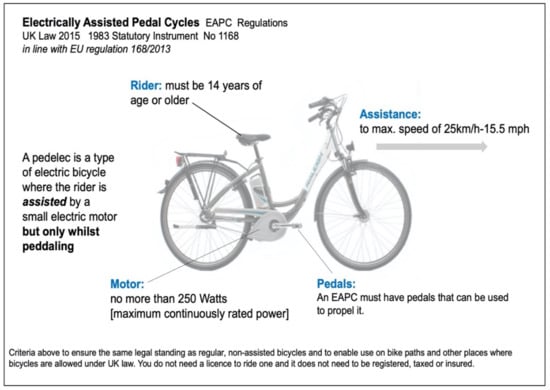
Figure 1.
Visualisation of key elements of [10] which harmonises with EU law [11].
This paper aims to explore how electrically-assisted cycling is experienced in hilly contexts, and what the impact of e-bikes on cycling in hilly areas is. After discussing the literature on cycling and e-cycling with a particular focus on hilly contexts, the methodology is outlined. The following results section on e-cycling in hilly geographies is structured by three key themes: practical benefits, practical issues, and psychological benefits. The discussion and conclusion highlight key findings as well as policy implications and suggestions.
2. Literature Review
Literature on sustainable transport highlights just how much change is needed to move from our current carbon-intensive mobilities to ways that slow down the warming of the planet [12,13]. A solid body of literature evidences the role cycling can play in theses required changes [14]. There is also an emerging body of literature that proposes broader conceptualizations of micromobility [15]. One of the proposed definitions suggests that micromobility includes solely human-powered modes such as cycling, but also electrically assisted modes such as e-bikes and e-scooters, as well as entirely motor-powered modes such as mopeds [16]. According to this ITF/OECD categorization of micromobility, the e-bikes used in this paper’s research would fall into the ‘Type A’ category of under 35 kg and being unpowered or powered up to 25 km/h. This literature intersects with a wider literature about the potential for cycling in hilly areas.
Hills are widely recognized as a barrier to cycling. For example, Parkin et al. found hilliness to be “a very significant indicator of the proportion that cycle to work”, confirming “the powerful effect of hilliness found by Waldman (1977)” [17] (p. 103) (Waldmann is out of print). The American Association of State Highway and Transportation Officials (Aashto) regards “slopes (or grades) greater than 5%” as “undesirable because climbing the ascents is difficult for many cyclists” as summarized by Tralhao et al. [18]. Broach et al.’s Oregon-based study of cyclists found that “slopes above 2%” were “one of the most important influential attributes” in their model and that “cyclists go significant distances to avoid such hills” [19] (p. 1739). In 2004, Parkin [20] measured the gradient using 50 m × 50 m digital elevation data. Where the average gradient was greater than 4% across a district he considered that a hilly area. Parkin and Rotherham [21] estimated that, on average, cycling 4 km up a 4% slope required 54% more energy and time than cycling on the flat. In regression models which estimate the level of cycling within an area, the barrier to cycling created by hilliness and the effort to get up hills have been found to be significant predictors [22].
Subsequent work by Philips et al. [23,24] has shown that, if hilliness is defined according to the slope of roads within an area, 8% of the population in England live in small areas (LSOAs—Lower Super Output Areas—The areal units defined for analysing the UK Census) where the roads in their locale are predominantly over 4%, and many more will live in areas where at least some of the roads are this steep, meaning that many potential cyclists will be affected.
Given the additional effort required by hills, hills are one reason why people choose to use or buy e-bikes. In a 2002 survey of 600 e-bike users in the UK, 13% of respondents mentioned ‘help with hills’ as reason for buying on electric bike and 37% reported the ease of use on hills as a main advantage of the e-bike over ordinary bicycles [25]. In a study by Dill and Rose [26], the ability to overcome hills was mentioned as a key reason for e-bike use in the context of Portland, Oregon, US, where 28 e-bike users were interviewed. They also reported that some of their study participants were enabled by the e-bike to “take more direct routes with more hills”, compared to those using a regular bicycle [26] (p. 3). Another study in the US context focused on Sacramento, and assistance was mentioned as a key enabler for cycling in hilly terrain, despite the relatively flat topography of the location [27] (p. 40).
As well as simply facilitating existing journeys, their potential to ‘overcome’ hills is also reported as a reason why e-bike use can lead to longer, faster or more frequent cycle trips. Several studies using surveys in different locations have found that e-bikers travel further than conventional cyclists, including work in Portland USA by Mcqueen et al. [28] and in Europe by Castro et al. [29], with the latter reporting that e-bikers in seven EU cities travelled, on average, 9.4 km per trip compared to an average of 8.4 km per trip for conventional cyclists. Both studies noted relative ease of cycling on hills as a contributory factor to the increase in journey lengths. In a Norwegain study on e-bikes, Fyhri et al. [30] found going faster up hill is the most common reason to use the assistance on an e-bike. Berntsen [31] logged the activity of 8 cyclists and e-bikers, and found that e-bikers achieved 35% travel time savings over conventional cyclists on hilly routes vs. 15% travel time savings on flat routes.
These benefits, in turn, translate into estimations that e-bikes could be viable for a considerably greater volume of cycling trips than conventional bikes. A study on the use of e-bikes in a hilly Portuguese city (Coimbra) calculated how the battery range and assistance available on an entry-level e-bike translated into making far more areas and trips feasible for cycling than would be the case using conventional bikes, and concluded that e-bikes are “a viable active transport alternative for hilly cities” [32] (p. 7). The Propensity to Cycle Toolkit in the UK has a scenario showing e-bikes increase the amount of cycleable journeys, such that they could increase the proportion of commuters cycling all the way to work to 26% [33]. Woodcock et al. [34] model e-bike usage behavior and acknowledge that including hilliness would further improve their model and tool.
Philips et al. [3] have used spatial microsimulation to estimate the physical capability to replace car travel by bike or e-bike, based on both the motor assistance provided by e-bikes, and the physical constraints of individuals. They estimate that the physical capability for car travel substitution by e-bike is, on average, more than double what can be replaced by conventional bike, noting hilliness as a contributory factor [35]. Bucher et al. [36] have looked at a different dimension of hilliness, considering the impact of altitude on climate and weather influences on e-bike use in Switzerland.
3. Materials and Methods
The empirical research material for this paper was collected during a 2012/13 e-bike study in Brighton and Hove. As the research gap on e-cycling in hilly contexts remained several years after the study, its material was re-analysed with this focus in mind. While e-bike technology has improved since (e.g., increase of the power of motors and the capacity of batteries), the fundamentals of assisted cycling remain the same: providing optional assistance to those riding the bikes. The main findings of this study therefore remain relevant. Where important, the results section discusses changes of e-bike technology compared to the time of research data collection.
Brighton and Hove is a city with around 290,000 inhabitants on the south coast of the UK, surrounded by the South Downs National Park. The topography comprises both flat areas (e.g., along the seafront) and hilly areas (see Figure 2). Two types of e-bikes were used (both low-step and cross-bar), each with three models of assistance (low, medium and high), see Figure 3 and Figure 4. For more detail on the types of e-bikes chosen, their motor, battery and assistance, see [37]. The dataset comprises the qualitative survey and the interview/focus group data (semi-structured) of 80 commuter trial participants in 2012 and 2013 and the GPS/sensor data for the 40 commuter trial participants who participated in 2013, plus 5 other 2013 (community group/self-ethnography) trial participants (see below). Many participants of the commuter trial were not regular cyclists before the trial and many had not cycled in years or even decades. They had a range of fitness levels, including those who self-reported to not be very fit. All received e-cycling training. For further detail on the recruitment of participants and the intervention design, see [4].
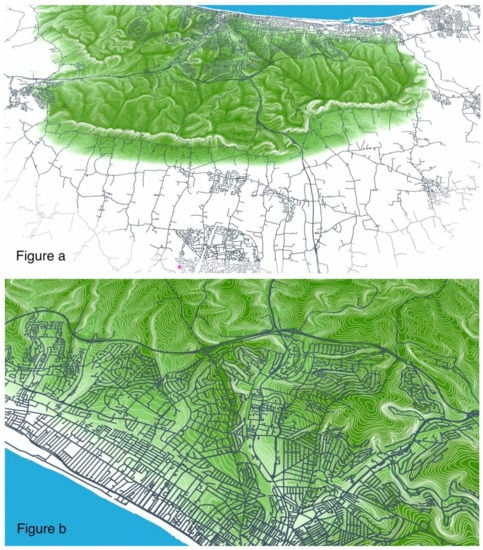
Figure 2.
Topographical overviews of Brighton and Hove, seen from the north (figure a) and selected area of the city, seen from the south (figure b).

Figure 3.
Two types of e-bike were used in user trials, the Raleigh Dover (left) and the Velo-cité (right); both low-step and cross-bar versions were used.
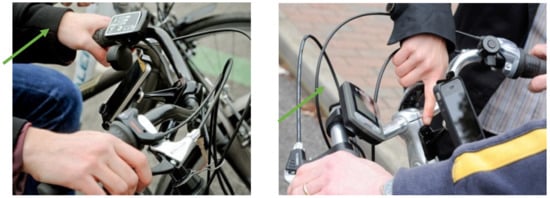
Figure 4.
The handle-bar mounted panel for switching the assistance on/off and selecting the level of assistance (low, medium, high), for the the Raleigh Dover (left) and the Velo-cité (right) model.
All qualitative material was transcribed, and then coded in NVIVO, taking an inductive approach. The sub-topics and quotes used in this paper were identified by running a matrix query in NVIVO with the nodes “assistance” and “hilly”.
All bikes used during the intervention were fitted with an open-source monitoring system designed to record GPS data and assistance-data in real-time [37]. Due to the experimental nature of the intervention, this Smart E-bike Monitoring System (SEMS) featured an evolving design. While in 2012, only GPS data was recorded, in 2013, the SEMS tracked how cyclists used the assistance on the e-bike, including whether the assistance was switched on or off, and, if switched on, reading which level of assistance had been selected (low, medium or high). The assistance data was recorded with a time stamp, and could therefore be analysed in conjunction with the GPS data recorded by SEMS. This 2013 data is analysed here. To our knowledge, this is the first time the actual use of assistance has been monitored in e-bike research.
Having identified relevant material by using the NVIVO nodes ‘assistance’ and hilly’, the GPS and assistance data recorded for 2013 trial participants providing relevant quotes were then visualized by creating an overlay of the route and the level of assistance used (none = blue, low = yellow, medium = orange, high = red) on a topographical map of Brighton and Hove and its surroundings. These could then be visualized alongside the quote that guided the selection of the relevant GPS and assistance data. The figures used in this paper are screengrabs of video visualizations of the material that can also be found online [38] see Figures 8–12.
The second way of engaging with the GPS and assistance data focused on hilly locations in Brighton. For this, we identified the ten largest hills in Brighton using GIS analysis of 3D maps using the OS Terrain 50 data [39], Open Street Map [40] and the Qgis2threejs plugin [41]. We then used MySQL to filter points with latitude/longitude inside the parallelograms and Excel VBA macro to join assistance data with location data for filtered sections. GridInquest (now OS Net) [42] was used to get distance and height in metres from the GPS. We only included those six hills in the analysis where more than ten uphill trips were recorded. The level of assistance on each e-bike was recorded as off (0), low (1), medium (2) and high (3) level of assistance. We analyzed the proportion of observations for each assistance level for uphill trips on these six hills.
It should be noted that analysing the assistance data in conjunction with the qualitative data was particularly helpful for identifying errors in the assistance records, such as an unlikely number of changes, and helped to ensure findings were robust.
4. Results
The NVIVO analysis showed that ‘assistance’ was referenced 308 times in 57 sources (out of 63).‘Hilly’ was one of the two nodes most frequently coded in conjunction with the node ‘assistance’, (the other node was ‘riding’ as in ‘action of using the bike’), as established through a matrix query of assistance in relation to all other nodes. Across the data set, three larger themes were identified for e-cyling on hills: (1) practical benefits, (2) practical issues, and (3) psychological benefits. Each of these has a number of sub-themes, as discussed in detail below. It is important to appreciate that the results relate to 2011 e-bike technology (and therefore that some of the limitations reported later in the paper might no longer apply).
4.1. Practical Benefits of E-Cycling on Hills
4.1.1. Facilitates Cycling Uphill
Many trial participants discussed the value of having assistance from the e-bike on hills: “wonderful—was able to cycle up hills”, “there was the extra help for going up hills”, “I found the electric bike really helped me in going up the hills”. This is closely related to other users that expressed how the pain and effort of uphill riding was reduced: “not a pain to go up the hill at all” and “going up the hill was brilliant, it was no effort whatsoever”. This, in turn, was then seen as making new journeys viable; for example, “I’ve cycled up some quite steep hills that I wouldn’t dream of cycling up without that battery on there that’s for sure”; “the bike certainly makes the uphill return commute possible”.
4.1.2. Ubiquitous Use on (Steep) Hills
It was also notable that, in the interviews and focus groups, almost all riders reported using assistance when going steeply uphill, regardless of their starting level of fitness. This is backed up by the data analysis of assistance and GPS data for uphill trips (excluding short trips of less than 50 m) on sections of 6 of the largest hills in Brighton where e-bike assistance use was recorded for more than ten trips. Of these, on the hill with the lowest gradient (5.3%), assistance was used for 39% of the trips, whereas on the other five hills with steeper gradients (7.9–9.9%), assistance was used for between 75% and 90% of the distance (see Figure 5). Both the analysis of the assistance data and the interview material (where specific street names were often mentioned) show that, on steep hills, with gradients of over 7%, some level of assistance was used by a large majority of riders.
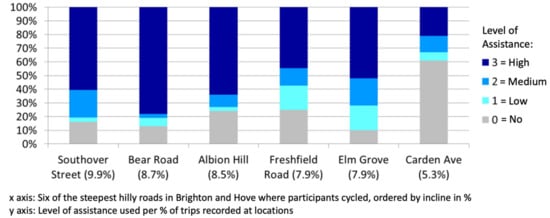
Figure 5.
Use of assistance (and levels) on six steep hills in Brighton (see Figure 6 for a map visualization).
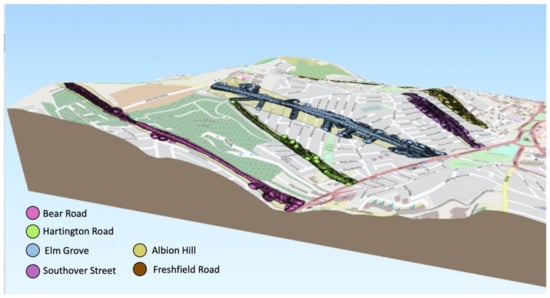
Figure 6.
Partial view (from the north towards the sea) of Brighton and Hove (with 5× vertical exaggeration); showing the Hanover/Queens Park areas where six of the ten steepest roads in Brighton are located. The recorded assistance data for trips on these roads are visualized. See Figure 5 for more detail.
In the post-trial survey, 66 out of 80 riders reported using a higher level of assistance (and none lower) when going uphill or against the wind (the survey question asked for both conditions together) compared to when cycling in ‘normal conditions’ (see also Figure 7 and Figure 8).
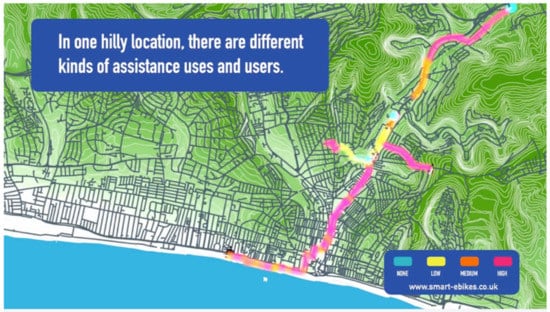
Figure 7.
Visualisation of multiple trips by multiple users, illustrating how different levels of assistance are used in the same or similar locations.
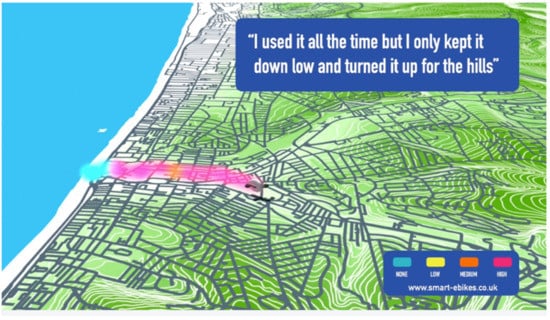
Figure 8.
Visualisation of a user trip where the assistance was increased when going uphill, with quote by the same user.
Whilst, in many cases, the highest mode was always used for hills, others would switch between levels, and only use ‘high’ in extreme situations.
The benefit of support on hills was also discussed in relation to other perceived benefits of e-cycling, such as reduced levels of sweating: “I would use three on the hilly bits near home especially on the way in [to work] so I didn’t get sweaty”.
4.1.3. Living or Working at the Top of a Hill
Several trial participants reported that they lived at the top of hills and that assistance made cycling home more feasible, for example: “My final homeward journey is nearly a mile uphill, and the extra power certainly made this part more manageable”.
Another rider compared the e-bike experience to a normal bicycle: “I live on a steep hill and normally, on my regular bike, I would have to stop halfway up because, for me, it’s too much and I found, when it was working properly, I could cycle all the way up from the bottom of the hill to my flat, and that was great”. This user also expressed an emotional response to making it to the top of the hill riding: “It felt like a real sense of achievement, you know, getting a bit of assistance and I was happy with that”. This illustrates how e-bikes can be an enabler of physical activity that participants did not think would be possible on an ordinary bike.
The sentiment of the assistance making it possible to cycle uphill is also echoed in the following, longer quote that also comments on the change of assistance mode and difference to normal cycling (for further examples see Figure 9 and Figure 10). This participant wrote in the pre-trial survey that their motivation was “mainly to find out if it helps with the hills of Brighton which is the main perceived barrier to [my] bike use”. In the post-trial interview or focus group, the same participant stated (see also Figure 11):
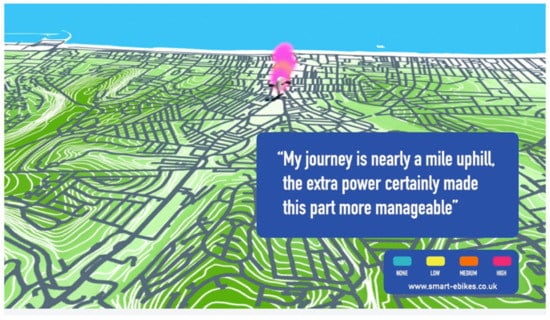
Figure 9.
Use of high assistance on a (slightly) uphill route northbound from the seafront.
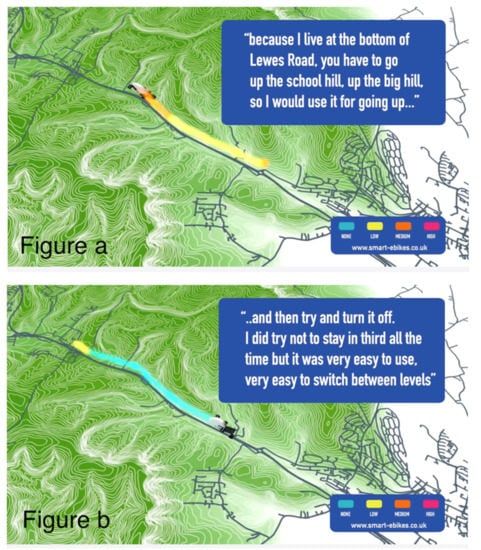
Figure 10.
Use of low assistance used for the uphill direction of a trip (a) and switching from low to no assistance on the downhill direction (b).
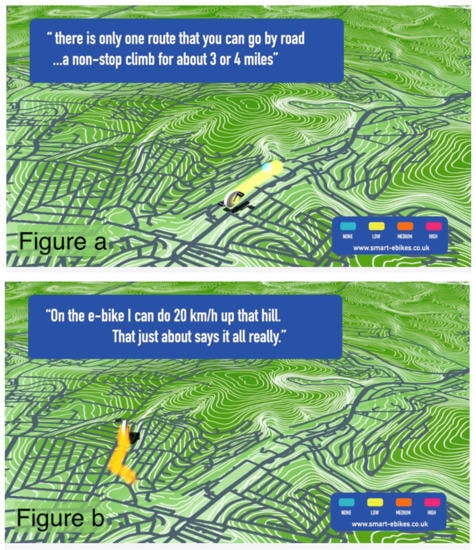
Figure 11.
Two moments of a participant’s trip: the beginning of the trip in low assistance (a) and a later section of the trip with a switch from low to medium assistance (b).
“There were days I did an awful lot of cycling to and from work and the bike is an absolute lifesaver. You can’t get up the hills that I go up and I live right at the very top of Ditchling road so there is only one route that you can go by road to there […] and that is a non-stop climb for about three or four miles. It is sort of not practical. I mean, yes, you can do it, I have got a mountain bike as well, it has got 24 gears, and you can kind of do it if you don’t mind your legs falling off. But I do. On the e-bike I can do 20 km an hour up that hill. That just about says it all really. […] You only have to get into moving out of the eco-mode at the very steepest bits […]. So it is an absolute lifesaver. It makes all the difference.”
4.1.4. Different Routes and Distances
Another practical benefit reported was that the use of the e-bike opened up different routes and distances for cycling in a hilly context. One participant stated: “The best aspects for me were the choice of routes that it opened up for commuting that actually come in over the hills and on the quieter roads and can be away from the traffic on routes that I wouldn’t be able to attend on a bike without assistance because it would just be too much”. In the UK, 24% of the National Cycle Network is on quiet minor roads [43]. Quiet minor roads are much hillier (up to 20% gradient) than the main road direct route (up to 8% on an A Road) [44,45]. While most conventional cyclists effectively ‘blacklist’ certain routes because of their hilliness, the switch to an electrically-assisted bicycle seems to have the potential to change mental cycling maps to include routes with inclines.
The following example concerns a commute that is both hilly and long (see Figure 12). The relevant trial participant lived in the Sussex countryside (north of Brighton) and had to cross the South Downs (a hilly range) via Ditchling Beacon. Ditchling Beacon is 7 miles north of Brighton and one of the three highest ‘peaks’ of the South Downs at a height of 248 m. Its steep north face is often used by race cyclists for training, and it featured in the Tour de France and Tour de Britain.
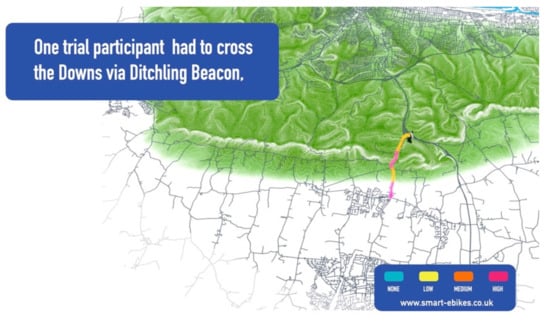
Figure 12.
Section of a long and hilly commute where a combination of high and low assistance is used.
4.1.5. Hill Starts
Starting on an uphill section requires quite a bit of strength to get a conventional bicycle up to speed on the incline. Several participants commented how the assistance made hill starts easier, for example: “on the uphill start, the assistance is amazing. It’s really helpful”. Another person stated: “Hill starts weren’t too bad. I had it pretty okay as long as I remembered to sort of do that pedal up and then whoosh”.
4.2. Practical Issues Raised
4.2.1. Hill Starts
Hill starts were discussed as benefit, as just described in Section 4.1.5. They are also listed here as an issue because one participant struggled with the hill starts: “The battery assistance got me easily uphill, but when the traffic stopped part way up, I couldn’t take off again safely as the bike was so heavy. Found it best to use full power and lowest gear, although still a bit wobbly”.
4.2.2. Battery
Participants discussed how e-bike use uphill impacted on the bike battery, e.g., “hills do flatten the battery”. However, these comments need to be understood in the context of the trial bicycles—The monitoring system was also powered by the bike battery (see Section 2 and [37], meaning it drained more quickly than regular e-bike batteries. Also, comparable e-bikes today would have at least double the battery capacity.
Some participants changed the level of assistance to preserve battery for uphill sections of their journey, for example: “I had it on low [assistance] as much as I could, I even had it off sometimes so I could save the high assistance for the hills”. There were also instances where participants ran out of battery on hilly rides. One reports how “coming back from my evening class, my battery was quite low [and then] ran out […] as I was going up the worst hill of that journey so I had to get off and walk so it really showed me what a difference it [the assistance] had made”.
4.2.3. Jerky Power Transmission
A small number of participants who were using the front-hub motor e-bike reported experiencing the motor to be a bit ‘jerky’ at times when riding uphill: sometimes “it felt like [the motor] was pushing and pulling and pushing and pulling” and “up those hills it would give me a bit of power and it would slacken” while they were still overall “fine going” uphill. Similar experiences are described as “when you’re going up a hill […], it’s almost like engage stop engage” and “the power occasionally disappeared for a second whilst on hills which was a little unnerving”. One participant reported “the power [i.e., assistance] failing on two separate hill incidences, with two different bikes” (i.e., also the mid-motor e-bike) but this experience was not shared by others.
4.2.4. Insufficient Assistance
A small number of trial participants reported that they found the assistance was insufficient to cycle uphill. For example, one participant reported: “even with the electric bike, I couldn’t get up the hill (…) I never had to get off the bike apart from this hill just at the back of the university, the really big steep hill going up towards Hollingbury”. This needs to be understood in the context of many trial participants having had little previous cycling experience, and many also not being very fit.
4.3. Psychological Benefits of E-Biking on Hills
4.3.1. Enjoyment
Enjoyment is the emotional response most frequently mentioned in conjunction with assistance and here are some examples for how this was expressed in the hilly context. One rider “did really enjoy that extra power that it gave particularly on hills” and another one reported that they would “get to the top and [be] riding around with a big grin on my face the whole time, and oh how easy this is”. Another rider stated: “going up the hills is good because I can then turn up the battery, then power through, so for that, absolutely loved it”, with another one describing: “Up the hill is amazing, absolutely amazing, but you have to be on first gear and set at 3 lights, the highest and then you take off and it’s brilliant, I mean you still get out of breath and you still have to ride but it’s brilliant”. It is well established that riders get exercise when riding an e-bike e.g., [46]. However, this captures an associated and important finding: the subjective enjoyment of the e-bike-enabled exercise.
4.3.2. Workout
One reason for switching assistance levels was related to physical activity, also in relation to hilly terrain. Trial participants reported that “going up some of the hills I went up on the bike I still felt as tired as if […] you had given me a really good work out” and “I had it in high assistance and I was still really really pressing to get it up there [onto the hill]” Also: “Southover St which is a massively steep hill […], I did it in the saddle but my heart rate was still completely up the toppish” (see Figure 5 and Figure 6 for detail about the road mentioned).
Many of the trial participants were not particularly fit and this is reflected in several statements. Thinking back to their first e-bike day, someone remembers having had “delusions of grandeur when it came to how much assistance it could give somebody of my physical stature to get up a long hill” as they “had pictures of myself flying to the top of it with no effort whatsoever and when I got to the top I was only just able to, actually, so yeah it was still difficult to get up a long steep hill” (note: they refer to Elm Grove, see Figure 5 and Figure 6). And another participant explains that they “had it in top [assistance] for most of the time” as they needed to get some basic fitness levels first, and could then “feel myself getting fitter [and then] using less [assistance] and I tried to limit [the] assistance…other than on a particularly steep hill”.
Previous research has identified the wish to reduce exertion and knee pain as a factor in e-bike use amongst older adults e.g., [47,48] and this also comes up in our research material: “Going up hills, the power helps so there is much less strain on my knee, so less pain and more cycling”. It was also reported that, by reducing the potential exertion required, the e-bikes helped to overcome excuses that people give themselves to not cycle (e.g., ‘I’m too tired today’ or ‘I might not make it’), thereby acting as an incentive to cycle/exercise.
4.3.3. Playing’ with Assistance and Gears
Participants discussed their use of assistance in relation to the gears. Half of the trial participants’ bikes had a 3-gear hub; the other half had a 7-gear hub (see also Section 3). Most had little cycling experience, which is important context for some of the comments in this section as less experienced cyclists often struggle with gears see e.g., [49] such as the skills needed to work the shifters efficiently and to shift down at intersections and at changes of slope. Wilson [50] explains how efficient use of gears is important in terms of both comfort, and efficient power output to optimize speed. In our study, the gear/assistance interaction is often described as ‘fiddling’ or ‘playing’. One participant with a seven-speed e-bike stated that “I could drop the gears down to about third and so still do some hills on eco” while they also outline a different approach: “to stay in seventh gear and then put the power up”. Overall, they “started using the gears more and fiddling with the power less” when climbing hills.
Another participant (using an e-bike with three gears) also remarked that they were “playing with the gears depending on whether it was a hill or flat and then adjusting it with the other three [assistance] settings”. They found that the smallest gear was not the most helpful uphill, as the assistance on the bike increased with the amount of pressure put on the pedals (up to a point). Some participants would have also enjoyed more than three gears, especially in relation to hills: “there were significantly less gears on the bike compared to my usual bike—This made cycling up very steep hills difficult”.
Several participants reported that they needed some practice to get the right combination of gears and assistance, especially when adjusting between different kinds of terrain, such as between flatter and hillier sections of a trip. These participants also stated that they became experienced with this after a little while. “Playing” is used various times by participants to describe the combined process of gear and assistance changes, e.g., “that’s why I’m using the term ‘playing’, because I kept changing”.
5. Discussion and Conclusions
It is widely accepted that hills are a barrier to cycling. Work by Parkin and Rotheram [21] suggests that a slope of 4% or more may require at least 50% more effort to cycle, and many residential districts have hilly topography. Meanwhile, it is also widely accepted that making it easier to cycle on hills is one of the benefits of an e-bike. According to work by Philips [3], ebikes, where power assistance augments the rider’s physical effort, could in some areas more than double the amount of car travel that could be replaced with use of conventional bikes [35].
This paper is the first to focus on e-cycling in hilly contexts and also the first to draw on sensor data of assistance use in conjunction with GPS data and qualitative data (interviews, focus groups surveys), thus making a robust and novel contribution to the literature on e-bikes and micromobility, as well as sustainable mobility and transport in general.
The findings in Brighton reinforce the importance of the electric assistance in making some hills ‘manageable’. On hills above a certain steepness, almost all participants chose to use the assistance, regardless of their cycling experience or fitness. For example, one participant reported: “the difference of altitude was sort of taken away, effectively because of the power that the bike gives […]—That was the main effective feature for me”.
For some participants, this, in turn, made some journeys possible that they did not previously consider. One important case was the commute trip for people living at the top of hills, which was relevant to several participants. In other cases, through using the assistance on hills, people reported being able to take more direct routes, or to travel faster, or to cycle for longer distances than would otherwise have been possible. Reduced journey times and longer travel distances as a result of e-bikes are also reported in the literature, as outlined previously.
However, the evidence reported in this paper highlights that the benefits may be more than just effort reduction. In addition, there may be a range of psychological benefits from use of e-bikes, since they affect the quality of the cycling experience, making it more enjoyable, less tiring and less intimidating. Being able to travel up a hill with reduced effort was often reported to generate euphoria, or a sense of achievement. For example: “Up the hill, […] then you take off and it’s brilliant, I mean you still get out of breath and you still have to ride but it’s brilliant”. For the bikes used in this study, and given the relatively steep hills in Brighton, this was often conflated with a sense of having done a ‘good workout’, since effort was still required—For some people, use of an e-bike meant the effort required became manageable or more fun. In other cases, the effort reduction was sufficient to avoid arriving somewhere hot and sweaty. People also reported ‘playing’ with combinations of assistance and gears, implying that they found a benefit from having additional options, and being able to optimise their experience.
The study also highlighted various specific issues, relating to safety and reliability, that may be relevant for bike design, sales and e-bike safety training. One issue raised by participants related to hill starts—a feature of the driving test, given that starting off uphill is not straightforward for any vehicle. Some study participants reported that the extra boost of power from the assistance made this much easier; others reported that the weight of the bikes generated problems. This, therefore, is one potentially important area of training.
Other issues with using bikes on hills related to loss of battery life, jerky power transmission and simply requiring more power given the nature of the hill and the participant’s fitness. Some of these issues were related to the GPS monitoring system also using the e-bike battery, and today’s e-bikes have more powerful batteries and motors. Still, this highlights that manuals and other customer information need to indicate that use on hills is relatively power hungry. Ensuring smooth delivery of assistance on hills may be a particularly important feature for bike design. It is also important that customers have a realistic idea of what they are purchasing—and appreciate that riding an e-bike will still require some effort. ‘Try-before-you-buy’ schemes may be particularly helpful in this respect. The findings also challenge arguments against investing in cycle facilities in hilly areas, since only a ‘hard core’ of people would cycle, and indicate that hills should not act as a reason to deselect locations for investment in cycling infrastructure.
In brief, therefore, the findings reported in this paper provide strong evidence that confirms previous studies which suggest that e-bikes may increase the likelihood of people cycling, since the benefits are not simply electrical assistance for particular journeys, but also relate to the enjoyment of cycling, and the viability of using a bike more generally. The findings therefore strengthen the case for policy support for e-bikes as a key transport mode, whilst also highlighting particular issues for e-bike training, manufacturing and sales. The insights from this paper are applicable for urban and sub-urban hilly areas across the UK, and internationally.
Future research on the role for e-bikes in hilly contexts could include empirical studies in other cities and countries (and with more recent e-bike technology); comparison to other modes of micromobility (for example electric scooters); evaluating the effectiveness of policy instruments that support e-bike uptake in this type of geography; regional, national and international modelling of the e-bike’s potential to reduce transport-related carbon emissions; the extent to which the additional features of e-bikes enable changes of car ownership; the potential for e-bike hire, leasing and shared schemes; and the role of e-bikes in providing more sustainable leisure and tourism opportunities. All of these are current research gaps that would extend this paper’s work.
Through work related to this paper’s study, Cairns et al [4] have shown that the e-bikes used in Brighton replaced 20% of car travel, and from this, Philips et al. [6] have extrapolated maximum CO2 savings of up to 8 million tonnes per year for the UK, with potential benefits in both rural and urban areas. Whilst these findings are not the focus of this paper, they help to underline the potential value that e-bikes have in transitioning to a healthier, lower-carbon society, whilst this paper highlights that the key role they play in reducing the deterrent of hills and the multi-faceted way in which they can make cycling more practical and appealing.
Author Contributions
Conceptualization, F.B.; Methodology, F.B. and S.C.; formal analysis, F.B. and S.C.; writing—original draft preparation, F.B.; writing—review and editing, S.C., D.R. and I.P.; visualization, D.R.; funding acquisition, F.B. All authors have read and agreed to the published version of the manuscript.
Funding
This research was funded by EPSRC grant number EP/J004855/1.
Institutional Review Board Statement
The study was approved by the Ethics Committee of the University of Brighton (29 May 2012 and 19 February 2013).
Informed Consent Statement
Informed consent was obtained from all subjects involved in the study.
Data Availability Statement
Selected data supporting the reported results can be found at https://researchdata.brighton.ac.uk/id/eprint/16/ as publicly archived dataset (accessed on 25 February 2021).
Acknowledgments
Thank you to Simon Ball and Sandra Woodjetts for their contribution to the GPS data analysis and visualisations, to Alan Summers for the data visualisations, to Clare Beaumont, Katie Millard and Su Buttress for their contribution to the coding of the interview transcripts and work on the survey data, and to Chris Kiefer for his work on the smart e-bike monitoring system that enabled the GPS and sensor data collection.
Conflicts of Interest
The authors declare no conflict of interest.
References
- Bednar-Friedl, B.; Wolkinger, B.; König, M.; Bachner, G.; Formayer, H.; Offenthaler, I.; Leitner, M. Transport. In Climate Change 2014: Mitigation of Climate Change: Contribution of Working Group III to the Fifth Assessment Report of the Intergovern-Mental Panel on Climate Change; Edenhofer, O., Pichs-Madruga, R., Sokona, Y., Farahani, E., Kadner, S., Seyboth, K., Adler, A., Baum, I., Brunner, S., Eickemeier, P., et al., Eds.; Cambridge University Press: Cambridge, UK; New York, NY, USA, 2014; pp. 599–670. [Google Scholar]
- European Commission Reducing Emissions from Transport—A European Strategy for Low-Emission Mobility. Available online: https://ec.europa.eu/clima/policies/transport_en (accessed on 2 June 2021).
- Philips, I.; Anable, J.; Chatterton, T. E-bikes and their capability to reduce car CO2 emissions. Preprint 2020. [Google Scholar] [CrossRef]
- Cairns, S.; Behrendt, F.; Raffo, D.; Beaumont, C.; Kiefer, C. Electrically-assisted bikes: Potential impacts on travel behaviour. Transp. Res. Part A Policy Pract. 2017, 103, 327–342. [Google Scholar] [CrossRef] [Green Version]
- Behrendt, F. Why cycling matters for electric mobility: Towards diverse, active and sustainable e-mobilities. Mobilities 2017, 1–18. [Google Scholar] [CrossRef]
- Philips, I.; Anable, J.; Chatterton, T. E-Bike Carbon Savings—How Much and Where? CREDS: Oxford, UK, 2020. [Google Scholar]
- De Coninck, H.; Revi, A.; Babiker, M.; Bertoldi, P.; Buckeridge, M.; Cartwright, A.; Dong, W.; Ford, J.; Fuss, S.; Hourcade, J.-C.; et al. Strengthening and Implementing the Global Response Supplementary Material. In Global Warming of 1.5 °C. An IPCC Special Report on the Impacts of Global Warming of 1.5 °C above Pre-Industrial Levels and Related Global Greenhouse Gas Emission Pathways, in the Context of Strengthening the Global Response to the Threat of Climate Change; Masson-Delmotte, V., Zhai, P., Pörtner, H.-O., Roberts, D., Skea, J., Shukla, P.R., Pirani, A., Moufouma-Okia, W., Péan, C., Pidcock, R., et al., Eds.; IPCC: Geneva, Switzerland, 2018. [Google Scholar]
- Haubold, H. The European e-Bike Market Is Booming, Latest Industry Figures Show–and There Is Potential for More. Available online: https://ecf.com/news-and-events/news/european-e-bike-market-booming-latest-industry-figures-show-and-there (accessed on 25 February 2021).
- Hawkings, A. Forget Electric Cars—e-Bikes Will Be the Top Selling EV in the Next Decade—The Verge. Available online: https://www.theverge.com/2019/12/16/21016306/electric-bike-ebike-sales-us-numbers-deloitte-cars (accessed on 25 February 2021).
- The Electrically Assisted Pedal Cycles (Amendment) Regulations 2015; The Stationery Office Limited: Norwich, UK, 2015.
- European Parliament and of the Council of the European Union. Regulation (EU) No 168/2013 of the European Parliament and of the Council of 15 January 2013 on the Approval and Market Surveillance of Two- or Three-Wheel Vehicles and Quadricycles; European Union: Brussels, Belgium, 2013. [Google Scholar]
- IPPC. IPCC Report Global Warming of 1.5 °C; Masson-Delmotte, V., Zhai, P., Pörtner, H.-O., Roberts, D., Skea, J., Shukla, P.R., Pirani, A., Moufouma-Okia, W., Péan, C., Pidcock, R., et al., Eds.; IPPC: Rome, Italy, 2018. [Google Scholar]
- Sorrell, S. Reducing energy demand: A review of issues, challenges and approaches. Renew. Sustain. Energy Rev. 2015, 47, 74–82. [Google Scholar] [CrossRef] [Green Version]
- Brand, C.; Götschi, T.; Dons, E.; Gerike, R.; Anaya-Boig, E.; Avila-Palencia, I.; de Nazelle, A.; Gascon, M.; Gaupp-Berghausen, M.; Iacorossi, F.; et al. The climate change mitigation impacts of active travel: Evidence from a longitudinal panel study in seven European cities. Glob. Environ. Chang. 2021, 67, 102224. [Google Scholar] [CrossRef]
- Abduljabbar, R.L.; Liyanage, S.; Dia, H. The role of micro-mobility in shaping sustainable cities: A systematic literature review. Transp. Res. Part D Transp. Environ. 2021, 92, 102734. [Google Scholar] [CrossRef]
- OECD/ITF. Safe Micromobility; OECD/ITF: Paris, France, 2020. [Google Scholar]
- Parkin, J.; Wardman, M.; Page, M. Estimation of the determinants of bicycle mode share for the journey to work using census data. Transportation 2008, 35, 93–109. [Google Scholar] [CrossRef] [Green Version]
- Tralhao, L.; Sousa, N.; Ribeiro, N.; Coutinho-Rodrigues, J. Design of bicycling suitability maps for hilly cities. Proc. Inst. Civ. Eng. Munic. Eng. 2015, 168, 96–105. [Google Scholar] [CrossRef] [Green Version]
- Broach, J.; Dill, J.; Gliebe, J. Where do cyclists ride? A route choice model developed with revealed preference GPS data. Transp. Res. Part A Policy Pract. 2012, 46, 1730–1740. [Google Scholar] [CrossRef]
- Parkin, J. Determination and Measurement of Factors Which Influence Propensity to Cycle to Work; University of Leeds: Leeds, UK, 2004. [Google Scholar]
- Parkin, J.; Rotheram, J. Design speeds and acceleration characteristics of bicycle traffic for use in planning, design and appraisal. Transp. Policy 2010, 17, 335–341. [Google Scholar] [CrossRef]
- Grudgings, N.; Hagen-Zanker, A.; Hughes, S.; Gatersleben, B.; Woodall, M.; Bryans, W. Why don’t more women cycle? An analysis of female and male commuter cycling mode-share in England and Wales. J. Transp. Health 2018, 10, 272–283. [Google Scholar] [CrossRef]
- Philips, I.; Watling, D.; Timms, P. Estimating individual physical capability (IPC) to make journeys by bicycle. Int. J. Sustain. Transp. 2018, 12, 324–340. [Google Scholar] [CrossRef] [Green Version]
- Philips, I. e-bikeCarbonReductionCapability. Available online: https://github.com/DrIanPhilips/e-bikeCarbonReductionCapability (accessed on 25 February 2021).
- Guthrie, B.N. Questionnaire Survey of Powabyke Owners. 2002.
- Dill, J.; Rose, G. Electric Bikes and Transportation Policy. Transp. Res. Rec. J. Transp. Res. Board 2012, 2314, 1–6. [Google Scholar] [CrossRef]
- Popovich, N.; Gordon, E.; Shao, Z.; Xing, Y.; Wang, Y.; Handy, S. Experiences of electric bicycle users in the Sacramento, California area. Travel Behav. Soc. 2014, 1, 37–44. [Google Scholar] [CrossRef]
- McQueen, M.; MacArthur, J.; Cherry, C. The E-Bike Potential: Estimating regional e-bike impacts on greenhouse gas emissions. Transp. Res. Part D Transp. Environ. 2020, 87. [Google Scholar] [CrossRef]
- Castro, A.; Gaupp-Berghausen, M.; Dons, E.; Standaert, A.; Laeremans, M.; Clark, A.; Anaya-Boig, E.; Cole-Hunter, T.; Avila-Palencia, I.; Rojas-Rueda, D.; et al. Physical activity of electric bicycle users compared to conventional bicycle users and non-cyclists: Insights based on health and transport data from an online survey in seven European cities. Transp. Res. Interdiscip. Perspect. 2019, 1. [Google Scholar] [CrossRef]
- Fyhri, A.; Heinen, E.; Fearnley, N.; Sundfør, H.B. A push to cycling—Exploring the e-bike’s role in overcoming barriers to bicycle use with a survey and an intervention study. Int. J. Sustain. Transp. 2017, 11, 681–695. [Google Scholar] [CrossRef]
- Berntsen, S.; Malnes, L.; Langåker, A.; Bere, E. Physical activity when riding an electric assisted bicycle. Int. J. Behav. Nutr. Phys. Act. 2017, 14, 55. [Google Scholar] [CrossRef] [PubMed]
- Sousa, N.; Gonçalves, A.E.; Coutinho-Rodrigues, J. Pedelec on a Hilly City: A Case Study in Coimbra. In Proceedings of the Energy for Sustainability International Conference 2017 Designing Cities & Communities for the Future, Funchal, Portugal, 8–10 February 2017; pp. 1–7. [Google Scholar]
- UKCRC Centre for Diet and Activity Research (CEDAR). England’s Cycling Potential—Results from the Department for Transport-funded Propensity to Cycle Tool Project; UKCRC Centre for Diet and Activity Research (CEDAR): Cambridge, UK, 2017. [Google Scholar]
- Woodcock, J.; Abbas, A.; Ullrich, A.; Tainio, M.; Lovelace, R.; Sá, T.H.; Westgate, K.; Goodman, A. Development of the Impacts of Cycling Tool (ICT): A modelling study and web tool for evaluating health and environmental impacts of cycling uptake. PLoS Med. 2018, 15, 1–22. [Google Scholar] [CrossRef] [Green Version]
- Philips, I.; Anable, J.; Chatterton, T. A small area estimation of the capability of individuals to replace car travel with walking, cycling and e-bikes and its implications for energy use. In Proceedings of the ECEEE Summer Study, Hyères, France, 3–8 June 2019; pp. 1097–1104. [Google Scholar]
- Bucher, D.; Buffat, R.; Froemelt, A.; Raubal, M. Energy and greenhouse gas emission reduction potentials resulting from different commuter electric bicycle adoption scenarios in Switzerland. Renew. Sustain. Energy Rev. 2019, 114. [Google Scholar] [CrossRef]
- Kiefer, C.; Behrendt, F. Smart E-Bike Monitoring System: Realtime open-source and open hardware GPS, assistance and sensor data for electrically-assisted bicycles. J. IET Intell. Transp. Syst. 2015, 10, 79–88. [Google Scholar] [CrossRef] [Green Version]
- Behrendt, F.; Cairns, S.; Raffo, D. The Smart e-Bikes Research Project. Available online: www.smart-ebikes.co.uk (accessed on 3 January 2021).
- Ordnance Survey OS Terrain 50. Available online: http://www.ordnancesurvey.co.uk/business-government/products/terrain-50 (accessed on 8 November 2020).
- OpenStreetMap OpenStreetMap Powers Map Data on Thousands of Web Sites, Mobile Apps, and Hardware Devices. Available online: http://www.openstreetmap.org/about/ (accessed on 12 February 2021).
- Akagi, M. Qgis2threejs. Available online: https://plugins.qgis.org/plugins/Qgis2threejs/ (accessed on 8 November 2020).
- Ordnance Survey Grid InQuest 7.0. Available online: https://grid-inquest.software.informer.com/ (accessed on 8 November 2020).
- Sustrans Paths for Everyone. Sustrans’ Review of the National Cycle Network 2018; Sustrans Paths for Everyone: Bristol, UK, 2018. [Google Scholar]
- Highways England CD 143—Designing for Walking, Cycling and Horse-Riding—DMRB. Available online: https://www.standardsforhighways.co.uk/dmrb/search/543c502a-e16c-450d-8dc1-d98bca255d9e (accessed on 25 February 2021).
- Highways England CD 109—Highway Link Design—dmrb. Available online: https://www.standardsforhighways.co.uk/dmrb/search/c27c55b7-2dfc-4597-923a-4d1b4bd6c9fa (accessed on 25 February 2021).
- Fishman, E.; Cherry, C. E-bikes in the Mainstream: Reviewing a Decade of Research. Transp. Rev. 2015, 36, 1–20. [Google Scholar] [CrossRef]
- Jones, T.; Chatterjee, K.; Spencer, B.; Jones, H. Cycling beyond your sixties: The role of cycling in later life and how it can be supported and promoted. In Transport and Sustainability; Emerald Publishing Limited: Bingley, UK, 2017; Volume 10, pp. 139–160. [Google Scholar]
- Leger, S.J.; Dean, J.L.; Edge, S.; Casello, J.M. “If I had a regular bicycle, I wouldn’t be out riding anymore”: Perspectives on the potential of e-bikes to support active living and independent mobility among older adults in Waterloo, Canada. Transp. Res. Part A Policy Pract. 2019, 123, 240–254. [Google Scholar] [CrossRef]
- Lovejoy, K.; Handy, S. Developments in Bicycle Equipment and Its Role in Promoting Cycling as a Travel Mode. In City Cycling; Pucher, J., Buehler, R., Eds.; The MIT Press: Cambridge, MA, USA, 2012; pp. 75–104. ISBN 9780262517812. [Google Scholar]
- Wilson, D.G. Bicycling Science; MIT Press: Cambridge, MA, USA, 2004. [Google Scholar]
Publisher’s Note: MDPI stays neutral with regard to jurisdictional claims in published maps and institutional affiliations. |
© 2021 by the authors. Licensee MDPI, Basel, Switzerland. This article is an open access article distributed under the terms and conditions of the Creative Commons Attribution (CC BY) license (https://creativecommons.org/licenses/by/4.0/).